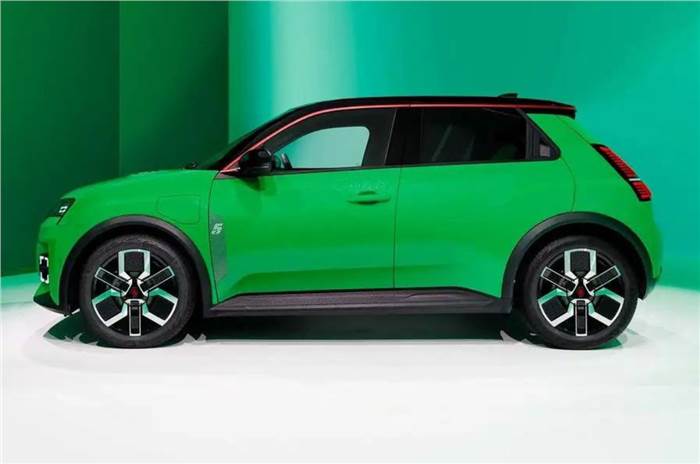The 5 is the first in a wave of upcoming retro EVs from Renault; gets up to 400km range.
The Renault 5 EV has been unveiled in production guise at the Geneva Motor Show. This is the first model in a wave of new retro electric cars that the French carmaker will introduce over the next couple of years. Taking heavy inspiration from the 1970s original, the new road-going Renault 5 remains a faithful translation of the acclaimed concept from 2021.
- Gets two battery options – 40kWh and 52kWh
- Has a maximum claimed range of 400km
- Design stays largely similar to concept from 2021
Renault 5 EV underpinnings, battery, range
The 5 is based on a new EV architecture dubbed Ampr Small (formerly CMF-BEV), and this shares much of its core structure with the Nissan Juke and Renault Clio. Using the fundamentals of an existing platform is said to have cut development costs by 30 percent, compared to engineering a bespoke platform like that of the electric Fiat 500.

The 5 will be offered with two battery packs – a 40kWh unit and a larger 52kWh unit – with nickel manganese cobalt (NMC) batteries batched into large square-shaped modules, thereby helping save some weight. As such, the 5 tips the scales at just 1,372kg with the entry-level 40kWh battery, and 1,449kg with the bigger 52kWh pack. Renault claims a range of 300km for the 40kWh car and 400km for the 52kWh version.
The 5 will be offered with a choice of three motor outputs: 95hp, 123hp and 150hp, with the mid-rung option claimed to deliver 0-100kph in less than 8 seconds. Cars with the smaller battery get 80kW DC fast-charging capabilities; 52kWh cars can charge at up to 100kW. In either guise, the 5 can supply up to 11kW to external devices via its charging port.
Renault 5 EV exterior design
The exterior is a blend of retro and modern cues and is largely based on the concept. However, it adopts a few subtle modifications: the front lighting signatures have been reworked, so the headlight projectors now use more conventional blocks of LEDs rather than the diffuse units on the concept.

A charging indicator has been integrated into the offset hump on the bonnet, which references the asymmetrical cooling vent on the original 5. This indicator fills a ‘5’ logo with light to represent the level of charge left in the batteries, allowing drivers to quickly gauge range without having to get in the car or check the app. Otherwise, the front end retains its blend of hard edges and swooping curves, mimicking the original 5.

The rear is similarly faithful to the concept, although the light bar that previously spanned the width of the hatch has been replaced with a slab of black plastic bearing the ‘Renault’ word and new ‘5’ badging.
Aerodynamics were a key consideration in adapting the concept for production: the roof-mounted lip spoiler, which harks back to the 5 Turbo, nets a claimed 8km of range; the mid-range Techno trim’s clean-faced alloy wheels gain another 8; and the slatted rear-light design provides a boost of about 6km.
Renault 5 EV interior, features
Renault has, for the first time, revealed the 5’s interior, which melds the clean-cut styling of the Megane with a brutalistic look inspired by the classic 5 Turbo.

The 10.0-inch instrument and infotainment screens are encased in chunky plastic shrouds designed to recall the homologation special’s analogue gauges, while the seats feature thick, corduroy-style padded inserts.
The dashboard, too, is inspired by the rally car, protruding into the cabin like a shelf and trimmed in one of several distinctive textiles depending on the chosen spec level; techno, for example, features swathes of denim. Leather is omitted in all cases and 18 percent of the car’s material content is recycled, including 41kg of polymers.

Renault 5 EV production
The Renault 5’s motors will be produced at the Cleon factory, which built engines for the original 5, as well as many other models including the Alpine A110, Renault Estafette van and even early Twingos. Vehicle assembly will take place alongside the Megane E-Tech at Douai, where batteries will also be produced when a new gigafactory is opened in mid-2025.
Also See:

